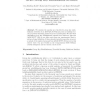Free Online Productivity Tools
i2Speak
i2Symbol
i2OCR
iTex2Img
iWeb2Print
iWeb2Shot
i2Type
iPdf2Split
iPdf2Merge
i2Bopomofo
i2Arabic
i2Style
i2Image
i2PDF
iLatex2Rtf
Sci2ools
IJISEC
2007
2007
Secure group key establishment revisited
Abstract. We examine the popular proof models for group key establishment of Bresson et al. [BCPQ01,BCP01] and point out missing security properties addressing malicious protocol participants. We show that established group key establishment schemes from CRYPTO 2003 and ASIACRYPT 2004 do not fully meet these new requirements. Next to giving a formal definition of these extended security properties, we prove a variant of the explored proposal from ASIACRYPT 2004 secure in this stricter sense. Our proof builds on the Computational Diffie Hellman (CDH) assumption and the random oracle model.
| Added | 15 Dec 2010 |
| Updated | 15 Dec 2010 |
| Type | Journal |
| Year | 2007 |
| Where | IJISEC |
| Authors | Jens-Matthias Bohli, Maria Isabel Gonzalez Vasco, Rainer Steinwandt |
Comments (0)

